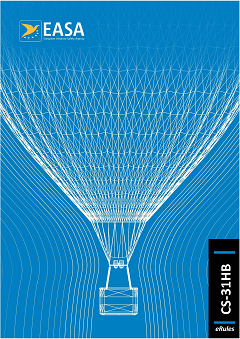ED Decision 2013/011/R
(a) Operating instructions are provided in a Flight Manual with each balloon.
(b) The Flight Manual contains:
(1) a description of the balloon and its technical equipment with explanatory sketches;
(2) operating limitations, minimum required crew, normal procedures (including mooring, inflation, deflation and tethered flight), emergency procedures, and other relevant information specific to the balloon’s operating characteristics and necessary for safe operation. This section of the manual requires approval;
(3) specification of the permissible lifting gas;
(4) information for ground handling, transport and storage; and
(5) site preparation instructions and installation information required for safe operation.
(c) The operating limitations, normal and emergency procedures, and other relevant information specific to the balloon’s operating characteristics and necessary for safe operation are provided to the crew.
AMC1 31TGB.81(b)(5) Flight Manual
ED Decision 2013/011/R
Site preparation and installation information
(a) The site preparation instructions include:
(1) the magnitudes and x-, y- and z-directions of each load carrying interface between the tether system and the ground;
(2) dimensions and categories of safety areas on the ground and in the air;
(3) the ground condition and its permitted maximum mean slope; and
(4) any additional safety area required by the emergency descent procedure, if applicable.
(b) The installation information includes:
(1) a list of the minimum installation crew and their necessary skills;
(2) a checklist of the necessary tools and devices for installing/de-installing; and
(3) a checklist describing the necessary sequential steps for installation/de-installation. The list highlights the safety critical phases including precautions and mitigating measures.
CS 31TGB.82 Instructions for continued airworthiness
ED Decision 2013/011/R
A Maintenance Manual and a maintenance schedule against which the balloon must be inspected and maintained in a serviceable condition is provided with each balloon.
(a) The instructions for Continued Airworthiness include information essential to the Continued Airworthiness of all parts and appliances of the balloon as required by CS-31TGB.
(b) The instructions for Continued Airworthiness are in the form of a manual or manuals as appropriate for the quantity of data provided.
(c) The format of the manual or manuals is provided in a practical arrangement.
(d) The instructions for Continued Airworthiness cover:
(1) detailed description of the balloon and its components, systems and installations;
(2) handling instructions;
(3) basic control and operating information describing how the balloon’s components, systems and installations operate;
(4) servicing information;
(5) a maintenance schedule against which the balloon is inspected and maintained;
(6) maintenance and inspection instructions;
(7) repair instructions;
(8) troubleshooting information; and
(9) airworthiness limitations that set forth each mandatory replacement time, inspection interval and related inspection procedure. This section of the manual requires approval.
AMC1 31TGB.82 Instructions for continued airworthiness
ED Decision 2013/011/R
Note: The paragraph numbering of this AMC relates to the paragraph numbering of CS 31TGB.82
(c) If instructions for continued airworthiness are not supplied by the manufacturer or designer of parts and appliances installed in the balloon, the instructions for continued airworthiness for the balloon need to include the information essential to the continued airworthiness of the balloon.
If manuals from different manufacturers are used, they need to provide a practical arrangement.
(d)(1) The detailed description of the balloon and its components needs to include for each balloon:
(1) a description of the systems including the assembly and disassembly instructions;
(2) a parts list covering all construction and equipment components and the assemblies. Where applicable, individual parts need to be numbered so that they can be related to the different assemblies and that their number corresponds to the type plate of the assembly; and
(3) a summary of the materials and consumables used with procurement details.
(d)(5) If applicable, the maintenance schedule may include instructions for continued airworthiness (e.g. recommended inspections or mandatory replacement of parts) to ensure the suitable protection of parts against deterioration or loss of strength, objective pass or fail criteria, e.g. applicable where tolerances need to be provided.
(d)(6) The maintenance and inspection instructions need to provide information for removal and installation, cleaning, inspecting, adjusting, testing and lubrication of systems, parts and appliances of the balloon as required for continued airworthiness. Reference may be made to information from an accessory, instrument or equipment manufacturer as the source of this information if it is shown that the item has an exceptionally high degree of complexity requiring specialised maintenance techniques, test equipment or expertise.
(d)(9) If the instructions for continued airworthiness consist of multiple documents, the Airworthiness Limitations section needs to be included in the principal manual.
CS 31TGB.83 Crew training and training information
ED Decision 2013/011/R
For a safe operation of the balloon, a training manual for crew is made available that contains as a minimum the following:
(a) Operating instructions and information as required by CS 31TGB.81;
(b) Minimum crew qualifications;
(c) Minimum training requirements, both theoretical and practical as appropriate;
(d) A method to show proof of successfully completing the training; and
(e) Recommended training requirements.
AMC1 31TGB.83 Crew training and training information
ED Decision 2013/011/R
The crew training and training information contains the following aspects when applicable to the operation of the balloon:
(a) general information on the training syllabus (theoretical and practical training) and examination;
(b) description of the system in sufficient detail to understand the principles of the balloon and systems;
(c) environmental conditions and their impact on safe operation;
(d) procedures for:
(1) mooring (high and low);
(2) flying;
(3) inflation and deflation; and
(4) emergency procedures;
(e) weather;
(f) maintenance; and
(g) record keeping.
